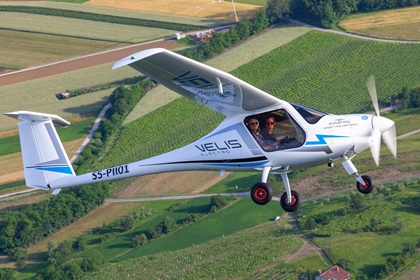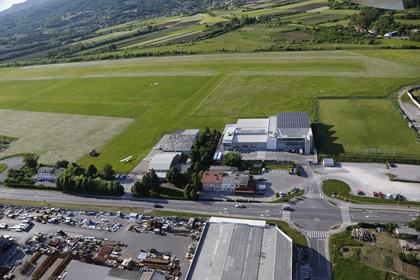Textron buys electric aviation pioneer Pipistrel
Market-disruptive deal subject to regulatory approval
Textron and Pipistrel, the electric aircraft pioneer based in Europe, jointly announced March 17 that the two companies have agreed to a deal that will make Pipistrel the centerpiece of Textron’s new electric aviation division.

Textron's move is likely to shake up the emerging electric aircraft market, vaulting the company that has been a general aviation giant for generations—but not known lately for a particularly fast product development pace—squarely into the front of the pack of contenders (notably including Colorado-based Bye Aerospace) that are developing electric aircraft.
Pipistrel was first in the world to certify an all-electric aircraft. European Union aviation regulators granted a type certificate for the Velis Electro in 2020, and Pipistrel reported strong sales of the two-seat aircraft in 2021, along with plans to hire staff and build both production and support capacity. Company officials said at the time that there remained no easy path to reciprocal certification by the FAA, which has yet to grant a type certificate to any all-electric aircraft. Such a pursuit was deemed cost-prohibitive. For Pipistrel, becoming part of Textron may change that.
Pipistrel will join the renowned brands of Cessna, Beechcraft, and Bell under the Textron umbrella, and anchor a newly created Textron eAviation business segment under which Textron plans to develop "sustainable" aircraft. Pipistrel, which has worked for decades to develop new aircraft and electric powerplants, is expected to become a Textron company when the transaction closes by the end of June, subject to regulatory approval, the press release noted.
“Pipistrel puts Textron in a uniquely strong position to develop technologies for the sustainable aviation market and develop a variety of new aircraft to meet a wide range of customer missions,” said Textron Chairman and CEO Scott Donnelly, in the news release. “Today’s announcement supports Textron’s long-term strategy to offer a family of sustainable aircraft for urban air mobility, general aviation, cargo and special mission roles.”
Textron reported executives were in transit and not immediately available March 17 to answer additional questions.
“Under my 30-year leadership, Pipistrel’s team has achieved a unique prime position in personal, affordable, environmentally friendly and electric aviation. The trend and foundation for future projects has clearly been set,” Boscarol said. “To drive Pipistrel’s ambitious goals and to continue its story of success, the joining of Textron and Pipistrel provides deep expertise and resources which would otherwise be inaccessible to Pipistrel alone. With Textron, we are together geared to strive for future growth and look forward to announcing exciting new products and projects. I am delighted to continue witnessing my vision become a reality by being actively engaged with the company for the future.”

While the joint announcement focused on electric aviation, Pipistrel has also caught the eye of many pilots with innovative petroleum-fueled aircraft models like the Panthera, a four-seat speedster that cruises at 200 knots and received a warm welcome upon its arrival in the United States. AOPA Pilot Editor at Large Tom Horne flew and reviewed the Panthera in 2021, reporting brisk sales of an experimental-exhibition version that was expected to pave the way for a certified version this year. “The Panthera looks like it’s going 200 knots just sitting on the ramp,” Horne wrote. “Its all-composite airframe has been optimized for low drag, so there's little frontal area and great attention to detail when it comes to fit and finish.”
Textron’s previous foray into high-speed, low-drag piston singles did not end well: The Cessna TTx, which was a rebrand of the Columbia 300 and the Columbia 400 aircraft that became the Corvalis TT, and was later rebranded the Cessna TTx proved to be a flop in a technologically advanced piston single market segment long dominated by Cirrus Aircraft. Textron sold 21 of the speedy singles in 2013 after that rebranding, but the TTx never really caught on—and Textron pulled the plug on that model in 2018. Cessna's last attempt to bring a new entry into the flight training market, the Skycatcher, was also a commercial flop.
“Hopefully Textron and Cessna have learned from past investments that didn’t go so well,” said aviation analyst Brian Foley, in a phone interview, noting that the acquisition of Pipistrel is similar in some respects to the Columbia acquisition, though very different in other respects. Pipistrel is a vibrant, thriving company known for innovation and engineering agility, while Columbia’s assets were purchased out of bankruptcy. Foley also noted that Columbia's expertise was building aircraft with modern composites: "The purpose for moving in that direction was to learn about composites, primarily,” Foley said, adding that while composites were once viewed as aviation's next big thing, they have not become ubiquitous, and many aircraft are still being made with more traditional materials. “I’m not sure they’ve used that education too much.”
Foley said electric propulsion is different from composite structures with respect to potential to disrupt the aviation landscape. “Electric, however, might be a little different this time around because it makes economic sense,” particularly for flight schools that stand to save significantly on fuel and maintenance costs. It will likely be some time, however, before battery-powered airplanes find missions beyond flight training. “Energy density just isn’t where it needs to be to power bigger airplanes.”

The companies did not immediately announce infrastructure plans, and Foley is among those curious to learn how much of Pipistrel's engineering and production capacity will move to Wichita, Kansas, or if Pipistrel will continue to do its work primarily in Slovenia and Italy.
“Hopefully [Textron will] leave them somewhat independent,” Foley said of Pipistrel. “They really need to keep doing what they’ve been doing well.”
Foley said the announcement following so closely after Textron announced FAA certification of its twin turboprop SkyCourier highlights the strength Textron brings to the mix, including resources, expertise, and a proven track record for achieving FAA certification. “They know the ropes,” Foley said of Textron’s certification successes.
Pipistrel also stands to bring expertise in uncrewed aviation to the Textron portfolio, creating opportunities to develop designs including an autonomous cargo drone dubbed the Nuuva V300 that Pipistrel unveiled in 2020. While at one point Pipistrel had eyed the emerging electric vertical takeoff and landing market for small-aircraft passenger service, Foley said the shift to focus on cargo for military and civilian markets was a smart move, given the challenge that eVTOL developers face with certifying aircraft with novel propulsion and control systems for passenger service.


